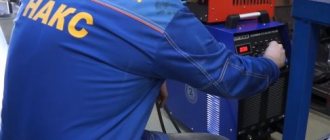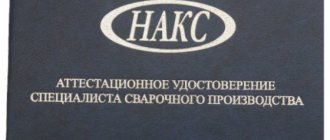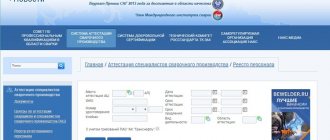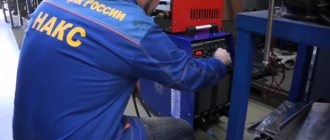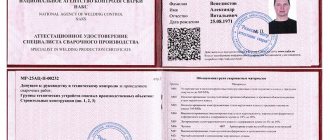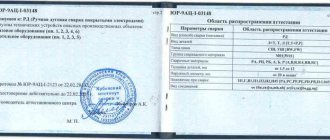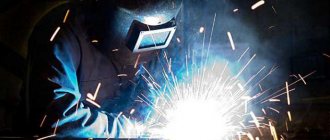ANO DPO "STC "Osnova" invites welders and welding production specialists NAKS to undergo training and certification. Classes are conducted on the basis of PB 03-273-99 and RD 03-495-02. After successfully passing the certification, we ensure that you receive a NAKS certificate and are entered into the NAKS register.
- The activities of NAKS are determined and regulated by the legislative acts of Rostechnadzor.
- Registration of welders and specialists is maintained in the open NAKS Register.
Head of Customer Relations Department
Description
1.2.
Certification of welders and welding production specialists is carried out in order to establish the sufficiency of their theoretical and practical training, test their knowledge and skills and grant the right to welders and welding production specialists to perform work at facilities controlled by the Gosgortekhnadzor of Russia. 1.3. The certification system for welders and welding production specialists (CASv) is a set of requirements that define the rules and procedure for the certification of welders and welding production specialists engaged in the manufacture, reconstruction, installation and repair of equipment and facilities, supervised by the Gosgortekhnadzor of Russia.
1.4. SASv defines:
- levels of professional training of welding specialists;
- structure and principles of formation of certification bodies;
- requirements for education and special training of welders and welding production specialists;
- procedure for certification of welders;
- procedure for certification of welding production specialists;
- procedure for maintaining the register of the certification system.
1.5. SASv establishes four levels of professional training:
- Level I - certified welder;
- Level II - certified master welder;
- Level III - certified welding technologist;
- Level IV - certified welding engineer.
Assignment of a level does not cancel the assigned qualification category according to the current system according to the All-Russian Classifier of Worker Occupations, Employee Positions and Tariff Classes (OKZ 016-94), put into effect by Decree of the State Standard of Russia dated December 26, 1994 N 367.
1.6. Certified welders and welding production specialists are allowed to perform those types of activities that are specified in their certification certificates.
1.7. Welding production specialists participating in the work of certification bodies must be certified for the right to carry out work on the training and certification of welders and welding production specialists.
Features of obtaining documents
After successfully passing the exam, the welder receives a certificate. Depending on his level, a master may be allowed to perform certain works. Certificates and certificates are issued to masters of all levels. Welders must undergo mandatory recertification. At the same time, ordinary craftsmen must do this every two years, chief welders - once every three years, and production engineers - once every five years.
The certification certificate contains information about what kind of work the welder can perform. Information about this has a letter designation. Experienced welders most often have several types of welding work in their certificate.
Despite the rather complex procedure for certification of welding technology and all welders working in production, only this can ensure high quality of manufactured products and safety. Regular production inspections and the need for craftsmen to take advanced training courses have a beneficial effect on the level of skill and performance of complex work. In addition, enterprises whose craftsmen have been certified have a higher chance of receiving orders for high-cost work.
Types of welder certification
Everyone working in the field of electric welding is required by law to undergo inspections as part of the rules for the certification of welders. Only after successfully passing the exams do they have the right to carry out work in their field. The work remains under the control of Russian technical supervision. Welding technology certification is divided into categories. Below you can see the certification types that people receive in any production.
Primary
Primary certification of welders is a procedure carried out by welders who have not previously had a permit.
Extraordinary
When studying information about which certification of a welder is considered extraordinary, you need to know that welders undergo it before being allowed to perform electric welding work after temporary suspension from work in case of violation of welding technology or repeated cases of poor-quality execution of electric welding connections.
Additional
People who wish to expand the work list of the certification card may obtain additional permission. Employees who have a break in their work related to their job responsibilities can also obtain permission.
Periodic
A periodic type of special inspection for welders is carried out in order to extend the period of operation of the document for work. Masters undergo a knowledge test according to the current Rules, which were approved by the country's supervision in the field of technology in 2000 (PB 03-273-99).
Certification levels
Why do you need a NAKS certificate? Today, its presence is a necessary condition for a specialist to perform welding work. The procedure and rules for certification that a welder undergoes are established by documents developed by NAKS. The procedure is carried out by certification centers, which are regional representative offices of NAKS. The certification commission includes certification experts who are certified and included in the NAKS register of experts, as well as representatives of Rostechnadzor. The received certificate confirms the professional level of the welder to perform specific work.
As part of the certification, the welder goes through several levels:
- Welder;
- Master welder;
- Welding technologist;
- Welding engineer.
Specialists of levels 2, 3 and 4, who are part of the management of enterprise divisions, must undergo mandatory certification. Specialists who need permission to work in hazardous or difficult conditions also undergo mandatory certification.
What is NAKS certification
Certification of welding technology NAKS is a confirmation of the professionalism of the welder. The received certificate indicates the specialist’s competence in his field, and also confirms that he is aware of safety rules, has welding techniques and can work with complex welding equipment.
The abbreviation NAKS itself stands for “National Welding Control Agency”. This organization certifies not only welders, but also engineering and technical workers related to welding work. Entry into the official NAKS register allows you to obtain permission to weld hazardous production facilities. Workers who are on this register can also count on an increase in wages.
How long is the permit valid?
Why is NAKS recertification needed? The certificates are valid for a certain time, which differs for different levels:
- I - no more than two years;
- II and III - 3 years;
- IV - up to five years.
During certification, examinees try not only to confirm their qualifications, but also to move to another level . We must remember that exams and obtaining a certificate, as well as its renewal, are paid.
N. A. Netudykhata, education: vocational school, specialty: welder of the sixth category, work experience: since 2002: “Having a wealth of experience as a welder, some workers move to the third level of NAKS and become technologists who are called upon to monitor the correctness of welding , but do not take direct part in the process.”
Who needs NAKS certification
Applications for NAKS certification are submitted not only by welders and welding masters, but also by technologists and engineers.
Testing the knowledge and skills of working personnel involved in the welding industry provides for the following types of NAKS certification:
- Welder NAKS. A specialist who passes this exam receives a certificate granting permission to work at critical facilities. The responsibilities of this worker include welding of any alloys and metals in all possible spatial positions. He also performs cutting, welding and planing work. A welder certified by the National Welding Control Agency is able to apply any type of weld and make rational decisions in the event of an emergency;
- Master welder. The requirements for a master are much higher. His competence includes not only welding. He also provides supervision over the activities of other welders and advises them in writing or orally;
- Technologist. The responsibilities of the technologist include monitoring the production processes of the enterprise, including welding;
- Engineer. The engineer's responsibility is to monitor compliance with the rules that govern the welding process. The engineer is also responsible for developing the documentation that approves these rules.
What are the verification levels?
There are four levels of certification for welders, so we will look at each in detail:
The first one confirms work as a welder and allows access to welding structures of any complexity.
The second is the foreman, he has the right to control all types of work, verbally or in writing.
The third one is received by technologists who are responsible for the quality of welding work at the enterprise. Level 3 NAKS is not a performer, but a representative of the quality control department.
The fourth is the junior engineering staff, whose responsibilities include direct management of the welding process, as well as approval of all types of documentation.
In addition to performers and managers, a general NAKS certification of welding production is carried out, which includes all equipment and tools used.
Certification of welders
Welders certified in accordance with the “Rules for the Certification of Welders and Welding Specialists” PB 03-273-99 are allowed to weld steam and hot water pipelines supervised by the Gosgortekhnadzor of Russia.
Welders who have not previously had access to welding pipelines controlled by Gosgortekhnadzor undergo primary certification.
Welders who have passed the initial certification are subject to additional certification before their admission to welding work not specified in their certification certificates, as well as after a break of more than 6 months in performing these works. At the same time, welders pass special and practical exams.
All welders undergo periodic certification in order to extend the validity of their certification certificates to perform the relevant work. During periodic certification, welders also pass special and practical exams.
Welders must undergo extraordinary certification before being allowed to work after temporary suspension. At the same time, they pass general, special and practical exams.
Welding of control joints is carried out in the presence of members of the certification commission. Control welded joints are subjected to non-destructive and destructive quality control.
Scope of certification:
- certification for welding butt welded joints of pipes applies to welding of butt welded joints of sheets;
- certification for welding butt welded joints of sheets in all spatial positions applies to welding of fixed butt welded joints of pipes with an outer diameter of 500 mm or more;
- certification for welding butt welded joints of sheets in the lower (H1) or horizontal (H) positions, as well as corner welded joints of sheets “in a boat” (H1) with or without full penetration applies to welding of butt and corner joints of pipes with an outer diameter more than 150 mm in the same positions.
The certification center issues the welder separate certification certificates for each welding method.
The welder performs control welded joints of sheets or pipes of the following types: with butt - SSh (BW) and/or fillet - USH (FW) welds. The welding positions of the control joints must correspond to those in which the welder will perform production welded joints.
Seam positions when welding sheet joints
Stykov
Corner
Seam positions when welding pipe joints
Stykov
Corner
H1 - lower with a horizontal arrangement of the axes of pipes (pipes) welded with a turn;
H2 - lower when the pipe is positioned vertically, welded without rotation or with rotation;
B1 - variable with a horizontal arrangement of the axes of pipes (pipes), welded (welded) without turning “uphill”;
B2 - variable with a horizontal arrangement of the axes of the pipes (pipes), welded (welded) without turning “downhill”;
G - horizontal with a vertical arrangement of the axes of pipes welded without rotation or with rotation;
H45 - variable with an inclined arrangement of the axes of pipes (pipes) welded (welded) without rotation.
P2 - ceiling with a vertical pipe axis, welded without rotation or with rotation
| Outer diameter of pipes, mm | The number of control connections is not less than: |
| Over 100 | 1 |
| Over 25 to 100 | 2 |
| Up to 25 | 5 |
When manual and mechanized welding in shielding gases with flux-cored wire, in order to obtain the right to perform work in all spatial positions, the welder must weld the most difficult joints. The dimensions (in mm) of control welded joints must correspond to the following values:
| t, mm | <6 | <6 |
| α,mm | ≤0.5 t | 0.5 t ≤ α ≤ z (z=0.7t) |
What is being checked?
The testing of theoretical knowledge includes the following questions:
- existing options for welding and surfacing of metals;
- types of suture joints used;
- types of control seams;
- what groups of basic materials are used;
- types of welding materials;
- position of joints during welding.
Testing of practical skills is carried out according to welding and surfacing methods - from a simple manual arc version using a consumable coated electrode (CD) to complex automatic ones, for example, automatic surfacing using submerged arc wire (AFPN). For a detailed list, see the regulatory documents of the Gosgortekhnadzor of Russia, paragraph 1.11.1 .
Procedure for certification of welding production specialists
The procedure for issuing a permit for electric welding work is as follows:
- The specialist sends the application to the certification service, attaching additional documents;
- Then the service checks the documents and begins the exam. The test begins with a practical test (if not passed, the welder can later pass the test, doing this no earlier than thirty days later).
- The third step is a mandatory one with an additional exam in writing or on a computer. The first test contains 20 mandatory questions and 15 optional questions. Topics are selected with the help of a specially assembled commission. They are compiled from a collection of topics. If a person was able to answer 80% of the topics correctly, then the state exam ends successfully.
- If the practical and theoretical exams are successfully passed, the commission will issue a protocol separately for the person for each welding. A conclusion with other documents responsible for quality control of welding joints will remain attached to the protocol.
The last step will be to obtain an electric welding certificate within the framework of the state example. The cover of a state standard document is made in a blue and red cover (for level 1 welders there is a blue frame, and for level 2-4 specialists there is a red frame).
Attestation process
Before confirming qualifications, the employee undergoes training and testing of knowledge on industrial safety at work. He provides the exam result to the center department. The qualification confirmation procedure includes several state exams: a single one with additional testing and practice. Employees with additional education in the production field with repairs and installation of materials from special polymer materials. They are exempt from the exam. During the certification process for management law with special technical control of electric welding work, employees pass the exam.
Simultaneous certification of employees of electric welding special production is permitted no more than within three groups of special technical facilities. Employees for the new group of technical devices take a special purpose exam.
Exam
At the first exam, the certified employee asks at least thirty questions to the certified employee, and at the additional exam, at least twenty questions and tasks in the field of industrial work. Examinations are conducted in written form. As part of the decision of the special commission accepting the exam, the certified person may receive an interview. An employee passes the mandatory exam if he answers most of the questions and successfully completes the practice assignment, taking into account an additional interview.
If an employee is certified for several working types, for example, electric arc welding or arc electric welding, the ticket for passing state exams must contain at least five topics about a special welding method. During qualification confirmation for site welding, which are classified as unsafe special technical devices, the specialist receives a specific series of tests to pass tests within each group of dangerous technical devices. The ticket must contain five questions in the group of special technical devices.
Stages
When testing the knowledge of theory and practical skills of an employee or manager, he is required to pass the following exams:
- practice of using welding equipment, if the test subject does not pass, then the certification ends;
- theoretical course.
In the first version of certification, practical actions are checked on the basis of GOST and documents developed by NAKS. If the employee has completed a practical task corresponding to his declared level, then he is allowed to take the second exam .
During the theoretical preparation test, the number of questions depends on the declared level: the first of them includes at least 15; and all subsequent levels have at least 20 questions. The survey is carried out electronically on a computer, but a written version is also possible - a test is given if the answer to 80% of the questions is positive.
If the subject has not passed the certification, he must undergo a re-test within three months.
Certification of welders
Welders are subject to certification for the right to perform welding and surfacing work using specific types (methods) of fusion welding, carried out manually, mechanized (semi-automatic) and automated methods when working at facilities controlled by Rostechnadzor.
Types of certification of welders:
- Primary certification - welders who have not previously had permission pass.
- Additional certification is carried out by welders who have already passed the initial certification, but who want to expand the list of works specified in the certification certificates, or by welders who have had a break in welding work for more than six months.
- Periodic certification – all welders who have already passed certification undergo it in order to extend the validity of their certification certificates.
- Extraordinary certification - welders undergo before being allowed to perform welding after their temporary suspension from work due to violations of welding technology or repeated cases of poor-quality welded joints.
Recommendations for employers
People often contact me to obtain a certification (certificate) for an electric and gas welder as a private individual. I try to explain to them that such documents are issued only after the employer provides the relevant documents (application and certificate). To which I hear the stupidest answer - “They don’t hire us without a crust.”
Dear employers, please read the Labor Code of the Russian Federation, it spells out in plain English the conditions for hiring specialists, and what documents can be required. An occupational safety certificate for a welder (and this is exactly what the certification being discussed is) is issued only after submitting an application from your organization. And subsequently this document is linked to the protocol (we usually provide a copy).
Unlike other certifications, the name of the organization is not written into the welder’s certificate, which is usually used by employers. But in general, according to existing standards, when moving from one organization to another, an employee is required to undergo recertification, and specifically from your company.
The procedure for certification of welders:
- The employer sends an application to the certification center in the prescribed form (see Appendix 1 to RD 03-495-02).
- Certification begins with a practical exam (in case of negative results, the welder can re-pass certification no earlier than after 1 month).
- General and special examinations are conducted in written form or using a computer. The general exam consists of 20 questions on the theoretical fundamentals of welding, and the special exam consists of 15 questions depending on the type of welding for which it is certified. Questions are selected by the certification committee based on collections of exam questions. If the applicant correctly answers at least 80% of the questions, the exam is considered passed.
- In case of successful completion of practical and theoretical exams, the certification commission draws up a certification protocol separately for each person being certified for each type of welding. The report is accompanied by a conclusion or other documents with the results of quality control of control welded joints.
- The certification center issues a separate certification certificate for each type of welding according to the established sample (see Appendix 15 to RD 03-495-02).
The cover color of the metal materials welder certification certificate is blue.
The cover color of the polymer material welder is green.
Documentation
How to obtain NAKS - before passing the certification you must provide the following package of documents:
- Application in writing.
- Educational documents - certificate or diploma.
- Certificate of professional training.
- An extract from the work book, certified by the HR department of the enterprise.
- Photo to be inserted into the ID.
- Copies of documents on passing TB standards.
- Medical certificate of health.
The list of documents may vary, depending on the level of the employee . Certification is carried out only on the basis of NAKS training centers.
Certification of welding production specialists
Certification of welding production specialists of levels II, III and IV is carried out in accordance with the direction of their production activities in the manufacture, installation, reconstruction and repair of equipment, pipelines and structures controlled by Rostechnadzor.
Types of activities of welding production specialists for which their certification is carried out:
- management and technical control of welding work;
- participation in the work of bodies for the training and certification of welders and welding production specialists.
Seam positions when welding sheet joints
Stykov
Corner
Seam positions when welding pipe joints
Stykov
Corner
H1 - lower with a horizontal arrangement of the axes of pipes (pipes) welded with a turn;
H2 - lower when the pipe is positioned vertically, welded without rotation or with rotation;
B1 - variable with a horizontal arrangement of the axes of pipes (pipes), welded (welded) without turning “uphill”;
B2 - variable with a horizontal arrangement of the axes of the pipes (pipes), welded (welded) without turning “downhill”;
G - horizontal with a vertical arrangement of the axes of pipes welded without rotation or with rotation;
H45 - variable with an inclined arrangement of the axes of pipes (pipes) welded (welded) without rotation.
P2 - ceiling with a vertical pipe axis, welded without rotation or with rotation
| Outer diameter of pipes, mm | The number of control connections is not less than: |
| Over 100 | 1 |
| Over 25 to 100 | 2 |
| Up to 25 | 5 |
When manual and mechanized welding in shielding gases with flux-cored wire, in order to obtain the right to perform work in all spatial positions, the welder must weld the most difficult joints. The dimensions (in mm) of control welded joints must correspond to the following values:
| t, mm | <6 | <6 |
| α,mm | ≤0.5 t | 0.5 t ≤ α ≤ z (z=0.7t) |
‹ Welding materials Contents Preparation of pipe joints for welding ›
Features of technology certification
Certification of welding production specialists is not enough for an enterprise to perform welding and produce products using it. First of all, certification of welding technologies is required. However, the enterprise does not independently determine the technology used and begin to use it. Only NAKS can decide which technology should be used at the enterprise, so preparation for obtaining a certificate must be global.
To obtain permission to use the technology, the management of the enterprise must submit an appropriate application. After which, on a set date, a commission arrives to check whether the equipment necessary for the work is available, whether there are any problems with the craftsmen, and whether fire safety and other standards are being observed.
Without certification of welding production, no enterprise that uses welding equipment can operate. Therefore, before obtaining permits, a commission is appointed, which determines the suitable technology used in production. The main task of the commission is to determine whether the equipment used is capable of producing products using a certain technology, and whether these products will meet quality standards.
Welding certification also includes checking the materials used in the work. It can be only metal or additionally plastic, polyurethane and other polymers are used. These points are subject to verification and certification, which will allow us to obtain certificates for finished products in the future.
Welding specialists who must undergo certification:
- at level II: specialists whose written or oral instructions are mandatory for welders to carry out when carrying out welding work (foremen, foremen, etc.);
- at level III: specialists who are heads of individual departments of the enterprise that ensure the implementation of welding work, and whose signature is necessary and sufficient for the use of documents defining the technology of welding work at the enterprise (heads of departments, laboratories, sectors, technical bureaus, heads of working groups, etc. .P.); at level IV: specialists who are managers of the welding service of an enterprise (organization), whose signature is necessary and sufficient for the management of the enterprise (organization) to approve guidelines and regulatory documents for the performance of all types of welding work (chiefs, their deputies, etc.).
What documents are issued?
What is a NAKS certificate - a certificate confirming that the holder of this document is allowed to work at all facilities under the control of Rostechnadzor . Each certified specialist receives a personal identification card with a personal photo, where the level is indicated and it is written down what types of welding work are allowed.
For example, when the letters RD are written, this is an admission to manual arc welding; RAD - welding using non-consumable electrodes; MP - mechanized method, etc., and The certificate contains only those types of welding for which the employee is qualified. Technologists and engineering staff receive similar certificates with access to certain types of work.
The procedure for certification of welding production specialists:
- The employer submits an application in the prescribed form to the certification center (see Appendix 18 to RD 03-495-02).
- Certification begins with a general exam, during which the specialist is asked 30 questions.
- A special exam is conducted, which consists of 20 questions and a practical task in accordance with the direction of production activity of a welding specialist.
- If the number of correct answers in the exams exceeds 80%, then the specialist is considered certified and, based on the results of the certification, minutes of the meeting of the certification commission are drawn up.
- Certified specialists are issued certificates of welding production specialists.
The cover color of the welding production specialist certification certificate is red.
Sources
- https://tk-servis.ru/lib/83/
- https://mrmetall.ru/attestacija-svarshhikov-i-specialistov-dlja-chego-ona-kak-proishodjat-vidy-attestacii/
- https://BurForum.ru/metally-svarka/vidy-attestacii-svarshchikov.html
- https://www.fsetan.ru/podgotovka-i-attestaciya-rabotnikov/svarshhiki-i-specialisty-svarochnogo-proizvodstva/
- https://weldering.com/attestaciya-svarshchikov
Sample certification for electric and gas welder
As such, there is no strict standard of certification (certificate) for electric and gas welders, so each training center distorts it as best it can (not to be confused with the NAKS certification). Below is a sample of certificates issued by the training centers with which we cooperate. So if you meet someone else, don’t be alarmed, this is what the management of this school has decided. establishments.
Certification (metals)
Member of the SRO Association "NAKS" (certificate of membership No. 0104) Corporation "Energokompleks" LLC conducts certification of metal welders according to the NAKS system. Current and planning to perform welding workers at Rostechnadzor facilities are invited to take the exams. Testing of practical skills and theoretical knowledge is carried out on the basis of the company’s certification center in Yekaterinburg in accordance with PB 03-273-99 “Rules for the certification of welders and welding production specialists” and RD 03-495-02 “Technological regulations for the certification of welders and welding production specialists” based on the submitted application for certification.
Documents required for certification
- Application for welder certification – DOWNLOAD
- Consent to the processing of personal data – DOWNLOAD
- Documents for initial certification – DOWNLOAD
- Documents for additional certification – DOWNLOAD
- Documents for periodic certification – DOWNLOAD
What documents does a certified welder receive?
Upon successful completion of certification, the employee is assigned level I of professional training and is issued:
- NAKS certificate entered in the register of the certification system for welders and welding production specialists.
- Protocol with the conclusion of the certification commission.
You can ask your questions to the specialists of Energocomplex Corporation LLC by phone or using the feedback form “Write to us”.
When filling out an application for certification of a welder, it is necessary to take into account the direction of his production activity and the following characteristics:
1. Welding method:
- RD – manual arc welding with coated electrodes;
- RAD – manual argon arc welding with a non-consumable electrode;
- MP – mechanized welding with a consumable electrode in active gases and mixtures;
- G – gas welding;
- MADP – mechanized argon arc welding;
- MPS – mechanized welding with self-shielding flux-cored wire;
- MPG – mechanized welding with flux-cored wire in an active gas environment.
2. Types of welds:
- SS – butt weld;
- УШ – fillet weld.
3. Type of parts (control welded joint - hereinafter referred to as KSS):
- L - leaf;
- T - pipe;
- L+T - Sheet + Pipe;
- C - rod.
4. Connection type:
- (C) - Butt;
- (T) - T-bar;
- (U) - Angular;
- (N) - Overlapping.
When certifying for welding reinforcement of reinforced concrete structures, welders perform butt, lap, cruciform or tee welding joints in accordance with GOST 14098-2014.
5. Connection type:
- os (bp) – one-sided welding without lining (on weight);
- os (sp) – one-sided welding on a removable or remaining lining, remaining ring;
- ds (zk) – double-sided welding with stripping of the weld root;
- ds (bz) – double-sided welding without stripping the root of the weld.
6. Groups of materials to be welded:
- M01 - Carbon and low-alloy structural steels of the pearlitic class with a yield strength of up to 360 MPa;
- M02 - Low-alloy heat-resistant chrome-molybdenum and chrome-molybdenum-vanadium steels of the pearlitic class;
- M03 - Low-alloy structural steels of the pearlitic class with a yield strength of over 360 MPa;
- M11 - High-alloy steels of austenitic-ferritic and austenitic classes.
7. Welding materials:
For welding welding joints, welding materials (electrodes, welding wire, tape, flux, gases, etc.) regulated by regulatory documents for welding by a specific method of connections from a specific group of base material or a specific combination of base materials of different groups must be used.
Metal coated electrodes for manual arc welding are divided into electrodes based on the type of coating:
- A - with sour coating;
- B - with cellulose coating;
- C - with cellulose coating;
- R - with rutile coating;
- RA - with acid-rutile coating;
- RB - with rutile base coating;
- RC - with rutile-cellulose coating.
8. Welding positions (must correspond to those in which the welder will perform under production conditions and his qualifications):
- H1 – lower butt and “boat”;
- H2 – lower tee;
- G - horizontal;
- P1 - ceiling butt;
- P2 - ceiling T-bar;
- B1 - vertical from bottom to top;
- B2 - vertical from top to bottom;
- H45 - inclined at an angle of 45 degrees.
Welding KSS
The types of joint connections performed by the welder during certification are determined by the certification commission, taking into account the application for certification.
Number of control welded joints:
- at least 5 pcs. – with an outer diameter of pipes up to 25 mm;
- at least 2 pcs. – with an outer diameter of pipes over 25 to 100 mm;
- at least 1 pc. – with an outer diameter of pipes over 100 mm;
One or more plates (sheets) with a length of at least 300 mm, depending on the declared scope of certification.
— From elements of reinforced concrete structures in accordance with GOST 10992-2012 – 3 samples.
© 2015-2018 Energocomplex Corporation LLC Ekaterinburg, st. Chkalova, 124, office 15 8, 3-666-817, 3-666-818


